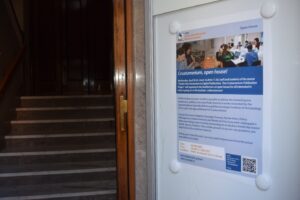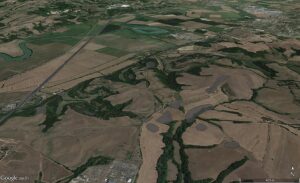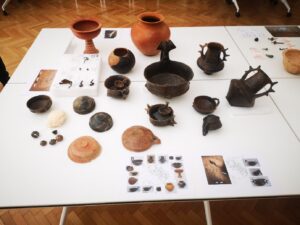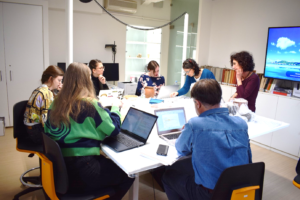On wednesday afternoon, April 26th, students from the practicum “Tombs from Excavation to Digital Publication, The Crustumerium Publication Project” concluded their course at the Institute with a small exhibition in the Institute’s Auditorium showcasing the grave inventories they had been working on during a one month intensive course led by Prof. Peter Attema of Groningen University.
Supervised by Etruscologist dr. Barbara Belelli Marchesini and archaeologist and restorer dr. Agnese Fischetti five students put five tomb assemblages on display consisting of gorgeous vases and well-wrought bronze and iron objects, all from Iron Age tombs tombs excavated by the Groningen Institute of Archaeology and the Soprintendenza of Rome at the Iron Age settlement of Crustumerium.
At this unique “Crustumerium Open House” manifestation, KNIR residents and invités could not only admire the carefully restored objects and learn about them from the students but also watch video’s of the actual excavations.
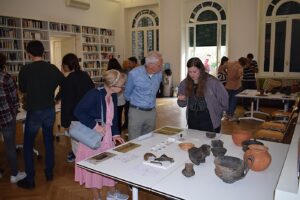
Student Renée de Vries explains “her” tomb assemblage consisting of pottery and metal ornaments to visitors.
The ancient Latin site of Crustumerium was inhabited from ca. 850 to 450 BC, and was never overbuilt – except for the occasional Roman villa. The settlement is located just north of Rome along the Tiber river.
In the 7th century BC – the period to which the exhibited tombs pertain – Crustumerium was home to a large number of families who buried their dead in the extensive burial grounds surrounding their 60 ha large town. The tombs and their inventories including human remains offer an unprecedented insight in the social structure of a community that lived at the “gates of Rome”, as was also shown at the 2016 exhibition in Copenhagen.
The ultimate goal of “The Crustumerium Publication Project”, born from a 12 year long intensive collaborative excavation effort of the Groningen Institute of Archaeology and the Soprintendenza Speciale di Rome between 2006 and 2018, is to publish the corpus of plus 400 tombs from the burial grounds surrounding Crustumerium showing all of their at times astonishing objects.
The course and exhibition – made possible thanks to a fruitful collaboration between KNIR, Groningen Institute of Archaeology and Superintendency of Rome, explicity aims at promoting Open Access Digital Publication. During the course, the supervisors and students of the course as well as the library staff of KNIR, Janet Mente and Diana Giofrè and the staff of University of Groningen Press, Margreet Nieborg and Dorien van Rheenen, convened online to discuss the concrete steps to be taken to realize this ambition.
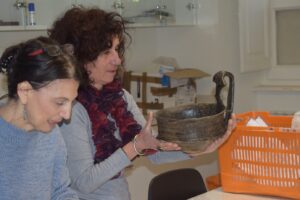
Teachers Barbara Belleli and Agnese Fischetti at work in the laboratory of the KNIR showing the students how to handle delicate objects, such as this beautiful ‘tazza cratere’.
The course profited immensely from the brand-new laboratory facility created in the basement of the KNIR. Here the precious objects could be safely studied and documented for the following step: digital publication!
By mid-June the students, Giuseppe Granata, Nynke Hoen, Polina Kolmogorova, Daiana Veronesi and Renée de Vries, will have completed the written work on the five tomb assemblages as part of their 10 ECTS course and have prepared five tombs for digital publication including the documentation of the funerary architecture, the human remains and the disposition of the actual objects in the graves.
Their work will add to the gradually growing corpus of catalogued tombs awaiting publication onto the digital platform that is in the making!
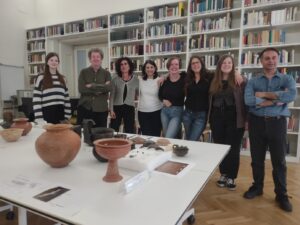
The “Tombs from Excavation to Digital Publication” team. From l. to r. Polina, Peter, Barbara, Agnese, Nynke, Daiana, Renée, Giuseppe
Thanks are due to:
– dr. Marta Baumgartner of the Soprintendenza Speciale of Roma who granted permisson to transport the Crustumerium tomb assemblages from the store rooms to KNIR
– dr. Walter Pantano who taught the students about human funerary osteology at Crustumerium during the course
– the staff of the KNIR who supported the course in many ways
– the staff of Groningen University Press of the University Library of Groningen University
Peter Attema
